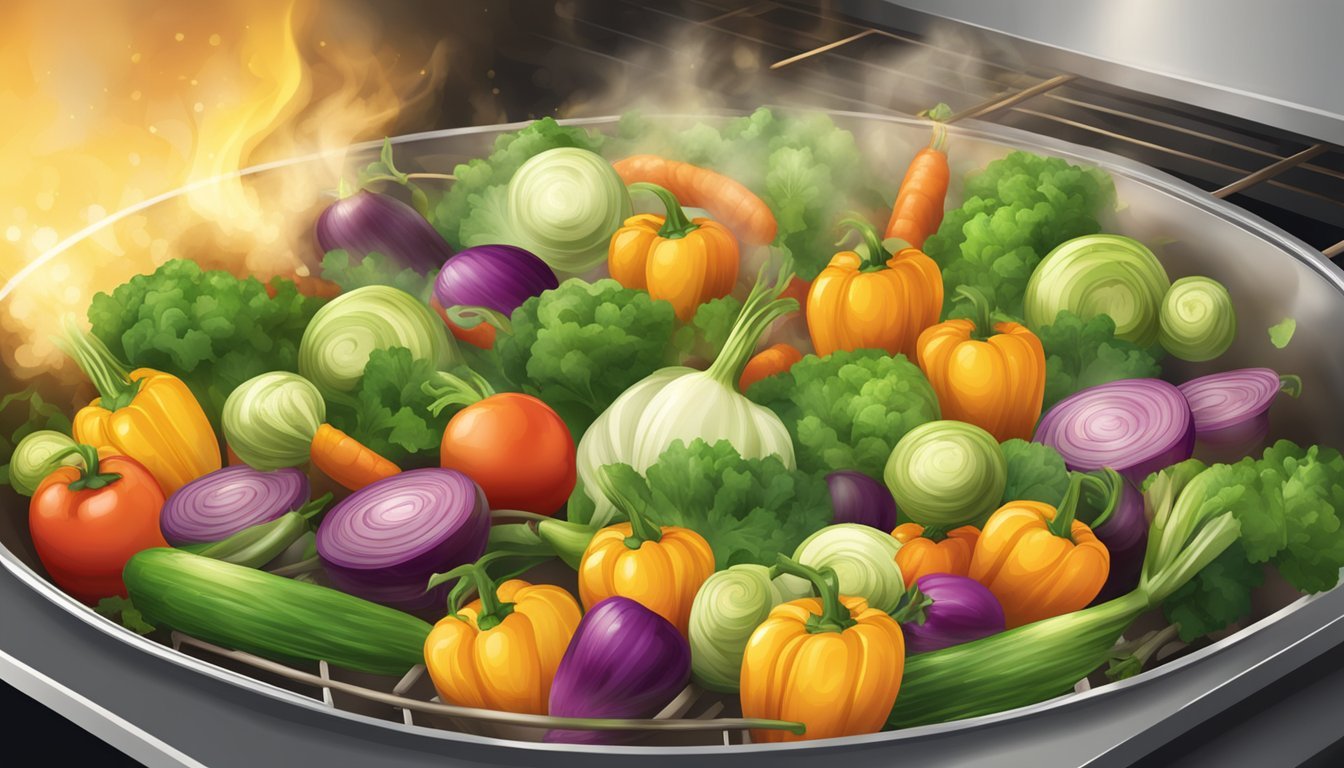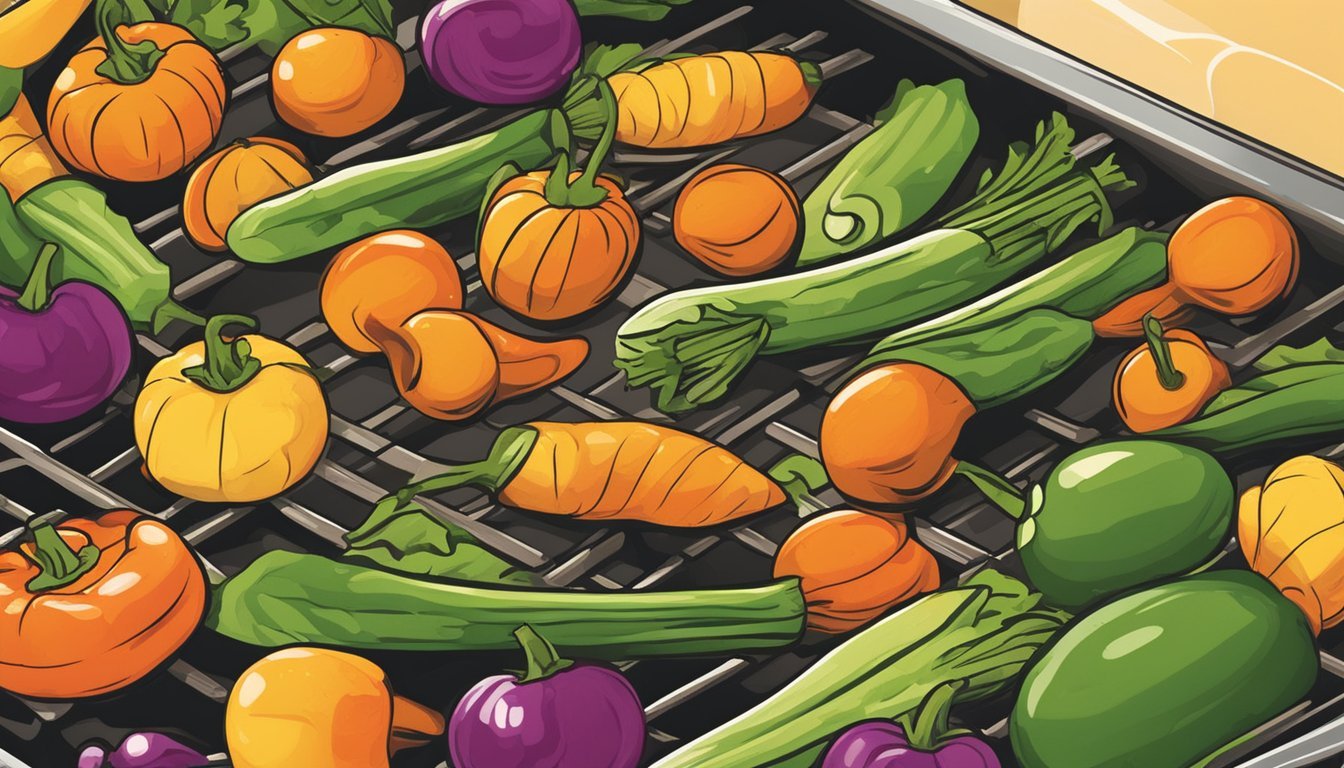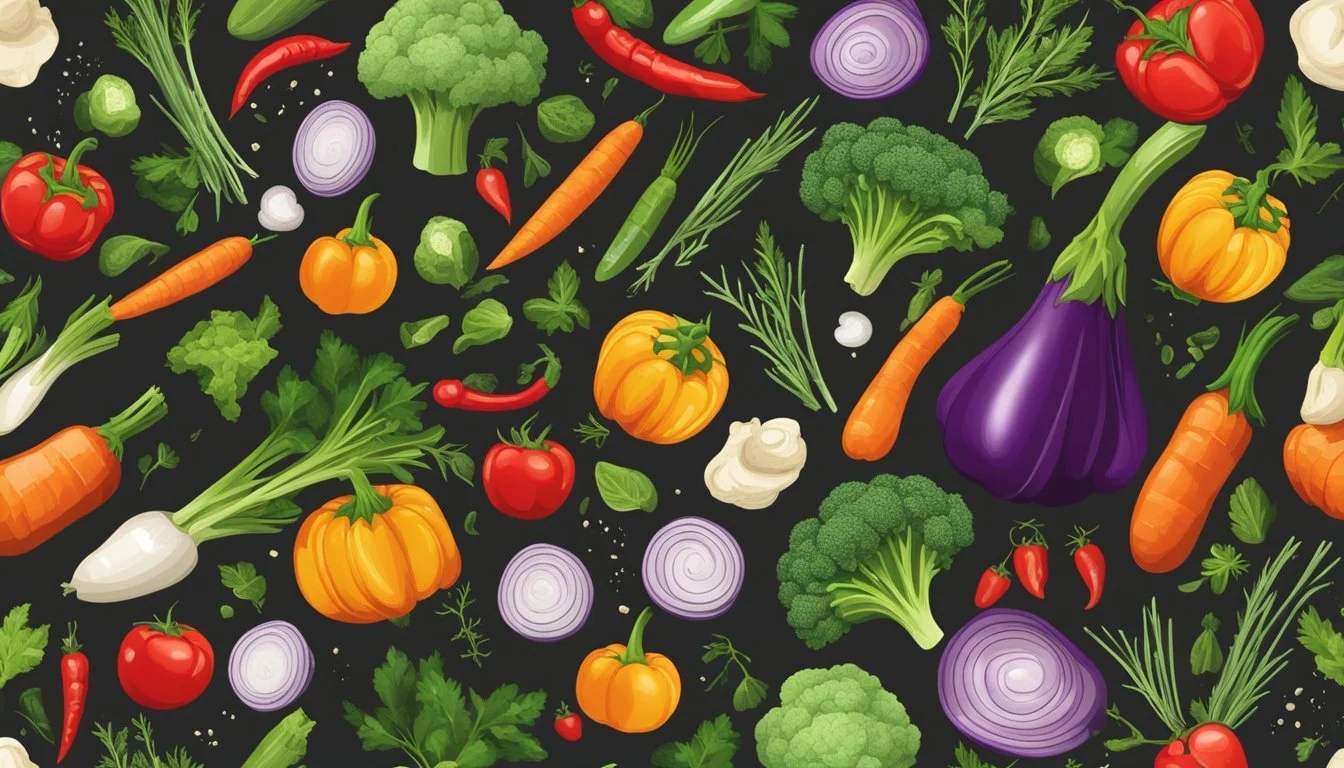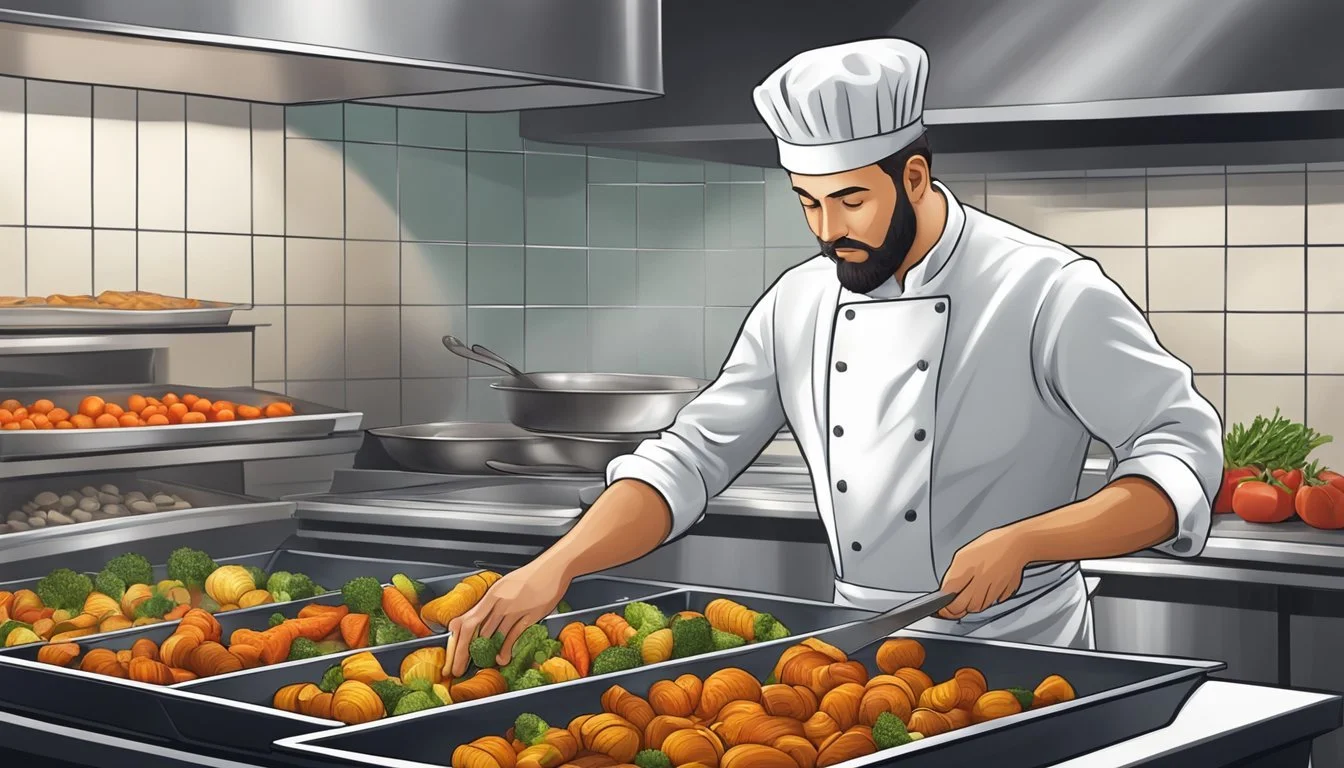The Art of Roasting Vegetables
Mastering Flavor and Texture
Roasting vegetables is a culinary technique that elevates simple ingredients into a delectable array of flavors and textures. This method, often performed in a hot oven, allows for a transformation where the natural sugars (how long does sugar last?) within the vegetables caramelize, resulting in a sweet and rich flavor profile. When it comes to roasting vegetables such as sweet potatoes, squash, and root vegetables like beets, the key is achieving the right balance of heat and time to ensure a golden brown, crispy exterior without compromising the integrity of their vitamins and natural taste.
To begin, vegetables should be cut into uniform pieces to promote even cooking and arranged on a rimmed baking sheet in a single layer. This spacing is crucial as it prevents steaming, ensuring each piece roasts properly. Vegetables with a higher water content, like tomatoes and zucchini, will cook faster and can become soft, while denser root vegetables, such as carrots and parsnips, may require longer roasting times. A thorough coating with a healthy fat like olive oil or avocado (how long does avocado last?) oil is essential, followed by seasoning with kosher salt, (how long does kosher salt last?) black pepper, and optional fresh herbs (how long do fresh herbs last?) or garlic to enhance their flavor.
Preheating the oven to a temperature between 400 to 450 degrees Fahrenheit sets the stage for optimal caramelization. Cruciferous vegetables like broccoli (how long does broccoli last?) and brussels sprouts (how long do brussels sprouts last?)transform into a crispy and delicious medley, especially when the edges attain that coveted golden hue. However, some vegetables, such as leafy greens, can turn into crispy chips with a shorter cooking time. Roasting not only provides a means to a tasty and healthful side dish, but also serves as the foundation for countless roasted vegetable recipes that are as nourishing as they are versatile.
The Basics of Roasting Vegetables
Roasting vegetables is a technique that enhances their natural flavors and textures. Through correct preparation and the use of proper equipment, these earthy foods can be transformed into delicious, caramelized delights.
Selecting Optimal Produce for Roasting
When selecting vegetables for roasting, it's key to consider the type's water content and density. Root vegetables like sweet potatoes, carrots, beets, and squash are ideal due to their low water content and high natural sugars, which lend themselves to caramelization and a crispy exterior. Cruciferous vegetables such as broccoli, cauliflower (how long does cauliflower last?), and Brussels sprouts also roast well.
It's important to cut the vegetables into uniform pieces to ensure even cooking. Dense vegetables should be cut into smaller, bite-sized pieces to reduce the roasting time, while softer vegetables like tomatoes can be cut into larger chunks or slices. Aim for a single-layer arrangement on the baking sheet to promote optimal caramelization.
Essential Equipment
The proper roasting setup includes a rimmed baking sheet or a roasting pan. The rim helps contain any juices and oils, preventing messes in the oven. Parchment paper or a silicone baking mat can be used to line the pan for easier cleanup and to prevent sticking.
Preheat the oven to a hot temperature, typically between 400 to 450 degrees Fahrenheit. This high heat is crucial for creating a delicious golden-brown finish and allowing the natural sugars to caramelize. Before roasting, tossing the vegetables in a light coating of oil, such as olive oil or avocado oil, along with seasonings like kosher salt and black pepper, is essential for flavor and to achieve that desired crispiness.
Experience the convenience and savings of buying a baking sheet or a roasting pan, parchment paper or a silicone baking mat, olive oil or avocado oil, kosher salt, and black pepper online!
Preparation and Seasoning
Proper preparation and seasoning are crucial for unlocking the full potential of roasted vegetables, (What wine goes well with roasted vegetables?) ensuring they are flavorful and cooked evenly.
Washing and Cutting Techniques
Prior to seasoning, washing and cutting your vegetables are essential steps. Start by thoroughly washing to remove any dirt, especially for root vegetables like beets and carrots. After drying with paper towels, move on to cutting. Uniform pieces are key for even roasting; dense vegetables like sweet potatoes should be cut into smaller, even-sized chunks, while softer vegetables like zucchini can be larger. Cruciferous vegetables like broccoli and cauliflower are best divided into uniformly sized florets.
Root Vegetables
Cutting technique: Even-sized chunks or slices
Cruciferous Vegetables
Cutting technique: Uniform florets
Soft Vegetables
Cutting technique: Larger pieces or whole if small
Ensure that the vegetables are spread out in a single layer on a rimmed baking sheet, to avoid overcrowding which can lead to steaming rather than roasting.
Seasoning for Flavor
Seasoning is all about enhancing the natural flavor of the roasted vegetables. A coating of olive oil not only aids in achieving a crispy exterior, but also helps seasonings adhere. Start with basics like kosher salt and black pepper, then consider adding garlic powder, (how long does garlic powder last?) Italian seasoning, or for a kick, a pinch of red pepper flakes (how long do red pepper flakes last?). A teaspoon of salt per pound of vegetables is a general guideline, but adjust according to taste and dietary needs.
For a nuanced flavor profile, incorporate fresh herbs like rosemary or thyme, and consider a sprinkle of sugar or a drizzle of balsamic vinegar (how long does balsamic vinegar last?) to enhance the natural sugars and caramelization. Use high-smoking point oils like avocado or canola oil for vegetables roasted at higher temperatures.
Remember that roasting time may vary; a hot oven around 400-425 degrees F is ideal for optimal caramelization, with most vegetables taking about 15-20 minutes to achieve that desired golden brown finish.
Online stores offer unbeatable prices for garlic powder, Italian seasoning, red pepper flakes, and balsamic vinegar, so don't miss out!
Cooking Techniques
Mastering the cooking techniques for roasting vegetables is key to achieving that desirable combination of a caramelized exterior and fully cooked interior. It's about understanding how vegetables respond to heat and how that heat is to be applied.
Oven Temperature and Timing
For optimal caramelization, the oven should be preheated to a high temperature, typically between 400°F to 450°F. Dense vegetables, such as sweet potatoes and root vegetables, require longer roasting times, often up to 30 to 50 minutes due to their higher starch content. Softer vegetables, like tomatoes and summer squashes, can take less, approximately 15-20 minutes, as they have a higher water content.
Root Vegetables (e.g., beets, butternut squash (how long does butternut squash last?): 400°F - 425°F, 30-50 minutes
Cruciferous Vegetables (e.g., roasted broccoli): 425°F, 18-25 minutes
Softer Vegetables (e.g., bell peppers, cherry tomatoes): 400°F, 15-20 minutes
Spacing and Layering
Vegetables should be spread out in a single layer on a rimmed baking sheet to ensure even cooking. Make sure not to overcrowd the pan, which can cause the vegetables to steam rather than roast, preventing that sought-after crispy exterior.
Single Layer: Ensures even exposure to the dry heat for crisping.
Spacing: Prevents steaming and allows for all sides to brown nicely.
Rotate: Halfway through cooking, rotate the baking sheet for uniform roasting.
Vegetables are best cut into uniform pieces to promote even cooking. In the case of mixed vegetables, each type should be considered; dense vegetables in larger pieces and softer vegetables in smaller pieces can balance the difference in cooking times when combined on a single baking sheet. Brushing the vegetables with a coat of olive oil or avocado oil, and seasoning with kosher salt and black pepper, beforehand enhances their natural flavor and assists in achieving a golden brown finish.
Advanced Roasting Tips
Before diving into the finer points of roasting, it's essential to understand that advanced techniques hinge on maximizing caramelization and achieving an even, crispy browning across all types of vegetables.
Enhancing Caramelization
Caramelization is the chemical reaction where natural sugars in food turn golden brown and develop a deeper flavor when exposed to high heat. To enhance this process for vegetables like sweet potatoes and butternut squash:
Temperature: Preheat your oven to a hot setting, typically between 400 to 450 degrees F. This high heat initiates quicker caramelization of the natural sugars.
Oil: Coat vegetables lightly in an oil with a high smoke point, such as avocado or canola oil, to promote an even caramelization without burning.
Baking Sheet: Spread the pieces on a rimmed baking sheet in a single layer to ensure each piece has enough space for the dry heat to circulate, preventing steaming.
Roasting Time: Denser vegetables like root vegetables may need a longer time, up to an hour, while softer ones like summer squash can take as little as 15-20 minutes.
Achieving Perfect Browning
For that ideal crispy browning that provides a delightful contrast with the soft interior of roasted veggies:
Uniform Pieces: Cut vegetables into uniform pieces to ensure all parts have an equal opportunity to brown.
Single Layer: Arrange vegetables in a single layer without crowding on a rimmed baking sheet. Overcrowding can lead to steaming rather than browning.
Seasoning: Sprinkle vegetables with kosher salt and black pepper before roasting to enhance browning and add flavor.
By applying these subtle yet effective techniques, you can elevate the natural flavor and texture of your roasted vegetables, turning a simple dish into a culinary delight.
Side Dishes and Main Courses
In the realm of cooking, roasting vegetables bridges the simplicity of preparation with the complexity of flavors, making them a versatile component that enhances both side dishes and main courses.
Incorporating Roasted Vegetables into Meals
Roasting transforms the humble vegetable into a dish that stands out for its rich flavors and textures. When preparing side dishes, one can consider the water content and natural sugars in vegetables, which contribute to the appeal of the final dish. A high water content, for instance, in squash and tomatoes, will require a longer roasting time to achieve a crispy exterior.
To start, choose the right type of vegetable. Dense vegetables like sweet potatoes and beets need more time in the oven, while softer vegetables, such as summer squash and bell peppers, are quicker to roast. Cut the vegetables into uniform pieces to ensure even cooking. The size of the pieces should be considered as well; larger pieces for dense vegetables and smaller for those with less density.
For optimal caramelization and natural flavor enhancement, toss the vegetables in a coat of high-smoke-point oil like avocado or olive oil, a sprinkle of kosher salt, and black pepper. Spread them in a single layer on a rimmed baking sheet lined with parchment paper to avoid sticking.
Place the vegetables in a preheated oven at a high temperature, around 400°F to 450°F, to allow for a golden brown hue and rich flavor. Root vegetables like carrots and potatoes may take around 30 minutes, while cruciferous vegetables like broccoli and cauliflower can take 15-20 minutes.
Here's an example of how to incorporate roasted vegetables into a meal:
Side Dish: Roasted root vegetables with fresh herbs and black pepper
Main Course: Roasted vegetable medley served over whole grain rice as a hearty main
Side Dish: Sweet potato chunks with a hint of cinnamon and smoked paprika (how long does smoked paprika last?)
Main Course: Squash and cherry tomato bake with garlic and pepper flakes
Roasted vegetables work splendidly as an accompaniment to proteins or mixed into salads, pasta (how long does pasta last?), and rice dishes. They also make flavorful additions to soups, and can transform the character of a dish from ordinary to outstanding with their roasted notes. The intense heat used in roasting draws out the natural flavors, leading to a medley of vegetables that have a sweet, caramelized outside and a tender interior.
In conclusion, the incorporation of roasted vegetables into side dishes and main courses is limited only by the imagination. With the right preparations, roasted veggies elevate a simple dish to a remarkable food experience.
Creative Seasoning and Flavors
Creative seasoning plays a crucial role in enhancing the extraordinary tastes and aromas that roasting brings out in vegetables. From selecting the appropriate oils to pairing herbs and spices, the right combinations can elevate your roasted vegetables to a new level of flavor.
Global Inspirations
When it comes to seasoning roasted vegetables, drawing inspiration from global cuisines can add an exciting twist to your dishes. For example, Italian-style might include a blend of garlic, rosemary, and thyme, while Indian-inspired roasted veggies could feature a warm mix of turmeric, cumin, and garam masala. (how long does garam masala last?) Asian influences might see vegetables tossed in sesame oil (how long does sesame oil last?) with ginger, soy sauce (how long does soy sauce last?), and a sprinkle of sesame seeds (how long do sesame seeds last?).
Mediterranean: Olive oil, lemon zest, oregano, and a touch of balsamic vinegar.
Mexican: Cumin, chili powder, cilantro, and a squeeze of lime juice.
Middle Eastern: Za'atar, sumac, and tahini (how long does tahini last?)-based dressing for a nutty, acidic finish.
Discover the endless possibilities of buying cumin and chili powder online!
Complementary Pairings
Selecting the right oil and herbs can bring out the natural flavors and sugars in vegetables, encouraging caramelization and creating a crispy exterior. For dense vegetables like sweet potatoes and butternut squash, roasting in a hot oven for longer periods brings out a golden brown color and enhances sweetness. Cruciferous vegetables like broccoli benefit from being cut into larger pieces and roasted with olive oil and kosher salt to achieve optimal caramelization. Avocado oil is another excellent choice for its high smoke point, complementing softer vegetables like zucchini and bell peppers.
For a simple yet effective seasoning:
Sweet Potatoes: Olive oil, kosher salt, black pepper, and a pinch of cinnamon.
Root Vegetables: Thyme, rosemary, and a splash of maple syrup (how long does maple syrup last?) or honey near the end of roasting.
Squash Varieties: Nutmeg (how long does nutmeg last?) and sage for a warm, autumnal flavor profile.
When it comes to cinnamon, nutmeg, maple syrup or honey online shopping is the way to go!
Choosing the right vegetables for the medley is also essential. Combine vegetables with similar roasting times or add those that cook quicker later in the process. Always aim for uniform pieces on a rimmed baking sheet in a single layer, ensuring each vegetable has enough space to roast evenly.
Incorporate layers of flavor by finishing with a drizzle of flavorful sauces or dressings. A zesty lemon-tahini dressing or a balsamic glaze can add depth to the final dish. Freshly ground black pepper and flaky sea salt (how long does sea salt last?) are final touches that should not be overlooked, as they seal in the medley of flavors you've combined.
Post-Roasting Practices
After roasting, vegetables require proper handling to maintain texture and flavor. This includes suitable resting, serving techniques, and effective storage for reheating.
Resting and Serving
Once removed from the oven, roasted vegetables such as sweet potatoes and root vegetables should rest on the baking sheet for a few minutes. This allows the exterior to stay crispy, while the inside remains tender. Vegetables with high water content, like squash, should be served immediately to prevent sogginess. For enhanced flavor, toss roasted veggies with fresh herbs, a drizzle of olive oil, or a pinch of black pepper and kosher salt just before serving.
Storage and Reheating
To store, let vegetables cool completely and place them in an airtight container; they can be refrigerated for 3-4 days. For reheating, spread the roasted vegetables in a single layer on a rimmed baking sheet and warm in a hot oven for 15-20 minutes at 350 degrees Fahrenheit. This method helps preserve the crispy exterior and natural flavor. Avoid using a microwave, as it tends to make the veggies soft and may unevenly reheat them.
Health and Nutrition
In this section, we explore the health benefits of incorporating roasted vegetables into your diet, looking at how the roasting process can affect their nutritional value.
Benefits of Roasted Vegetables
Roasting vegetables is not only a culinary technique to enhance their flavor, but it also retains most of their nutritional benefits. Roasted veggies maintain a significant amount of their vitamins and minerals, even though some water-soluble nutrients like vitamin C and some B vitamins can partially degrade when exposed to heat.
Maximizing Nutrition: Different types of vegetables require varied roasting times. Dense root vegetables like sweet potatoes, beets, and butternut squash may require a longer time in a hot oven to reach a crispy exterior and fully develop their natural sugars through caramelization. Cruciferous vegetables, such as broccoli and cauliflower, should be cut into larger pieces and roasted until they are golden brown, to maintain their nutritious qualities while developing a pleasant, slightly nutty flavor.
Oil Choice and Usage: A modest amount of olive oil or avocado oil can be used to lightly coat the vegetables before roasting, which helps to achieve optimal caramelization and prevent sticking to the rimmed baking sheet. These oils are a healthy choice, offering beneficial monounsaturated fats.
Consistent Cooking: Vegetables should be spread in a single layer on the baking sheet, avoiding overcrowding, to ensure even cooking and optimal caramelization. The type of vegetable, as well as the size and uniformity of the chunks or slices, will dictate the necessary roasting time, generally ranging from 15-20 minutes.
Seasoning: To season your vegetables, a simple combination of kosher salt and black pepper often suffices, though you can also add fresh herbs, garlic, or pepper flakes for variety, both for taste and additional health benefits.
Roasting can transform the natural flavor of vegetables, making them more appealing to many people by enhancing their natural sweetness. Serving roasted vegetables can be a delicious and nutritious part of a balanced diet.










